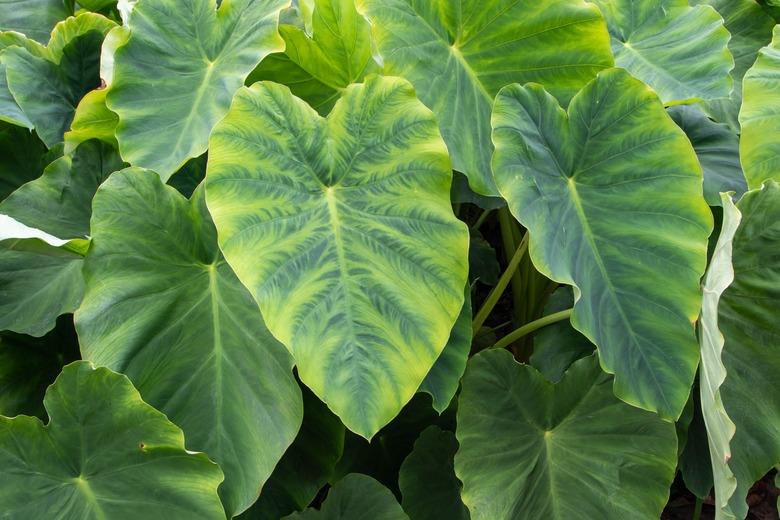How To Winterize Elephant Ears
We may receive a commission on purchases made from links.
The care and effort it takes to winterize elephant ears (Colocasia spp.) — which are perennial in U.S. Department of Agriculture plant hardiness zones 8a through 12b with some variation among species — depends on your climate. In frost-free tropical and subtropical areas, these lush foliage plants grow year-round with minimal winter care. In colder climates, gardeners can grow these plants as an annual during the growing season or overwinter the plants by bringing them indoors or digging up the tubers for storage until spring. Overwintering elephant ears outdoors takes a little more effort, but it's worth it when the heart-shaped leaves, which can reach 3 feet long or more depending on the species, bring a tropical flair to the garden the following summer.
Overwintering Elephant Ears Outside
Overwintering Elephant Ears Outside
In USDA zones 10b and above, elephant ear plants can grow year-round, remaining green through the winter. However, foliage can be damaged anytime temperatures drop into the 30s, and special attention still needs to be paid so that you can keep them looking healthy. In zones 8 and 9, elephant ears will die back to the ground in winter but can survive the cold months to return in spring. Here's how to overwinter elephant ears if you live in a mild climate:
- Discontinue watering. The soil can dry out completely during the dormant period (from late fall through winter), but natural rainfall will likely keep the soil moist.
- Cut back dead or frost-damaged foliage. Elephant ear foliage dies back throughout the year, but winter is a good time to tidy plants. Cut the stalks to 2 to 4 inches from the soil line as they die.
- Protect with mulch. If you live in zone 8 or 9, mulch the plant well to keep the soil temperature warmer in winter. Some elephant ears are more winter hardy than others, so check with your garden center or grower regarding the hardiness of your plant.
Tip
Sanitize your shears before and after cutting elephant ears or any other plants in the garden to help prevent diseases from spreading. Use one part bleach and nine parts water. Dip each blade in the solution for five minutes and then rinse and air dry.
Overwintering Elephant Ears Inside
Overwintering Elephant Ears Inside
In cold areas, you have three options. You can grow elephant ears in pots and keep them as houseplants, you can keep them in pots in a dormant state in a frost-free area over winter, or you can dig the corms in the fall and replant in the spring.
Overwintering Elephant Ears in Containers
Elephant ears growing in a container cannot survive cold winter temperatures and should be brought indoors before the first frost. It's possible to keep an elephant ear as a houseplant for the winter months. To do so, cut back all but the two top leaves, place it in a cool spot with bright light, and continue watering but take care not to overwater the semidormant plant.
Overwintering Elephant Ears in a Dormant State
For a lower-maintenance approach, many gardeners choose to let their potted plants go dormant for winter. Follow these instructions for overwintering a dormant plant:
- Move the container. Move either potted plants or corms before the first frost. Move the pots into an unheated garage, shed, basement, or other dry place that stays at a temperature between 45 and 55 degrees.
- Reduce watering. Water very lightly and only as needed to keep the potting medium from completely drying out during dormancy.
- Cut all the stalks down to the base of the plant. Use a clean, sanitized cutting tool.
- Resume watering. Next spring when you spot new growth, start watering the plants again.
- Return the pots outdoors. Once the last frost has passed, you can return the pots to the outdoors.
Digging and Storing Elephant Ear Corms
Here's how to dig and store elephant ear bulbs (or corms as they are more accurately known):
- Allow the leaves and stalks to die back. Once dead after the first couple of winter frosts, cut back the foliage and then carefully dig out the corms.
- Brush soil off the surface and pack the corms for storage. Allow the corms to dry for two to three days and then brush off extra dirt and pack the corms in dry vermiculite, sand, or peat moss in an open bucket or tub.
- Keep the corms dry. Ideally, put them in a spot with 45- to 55-degree temperatures throughout winter.
- Replant the corms in spring in rich, well-drained soil. After all danger of frost has passed and daytime temperatures remain above 70 degrees, plant the corms 2 to 6 feet apart and 4 to 6 inches deep depending on the species and the size of the corms, respectively.
